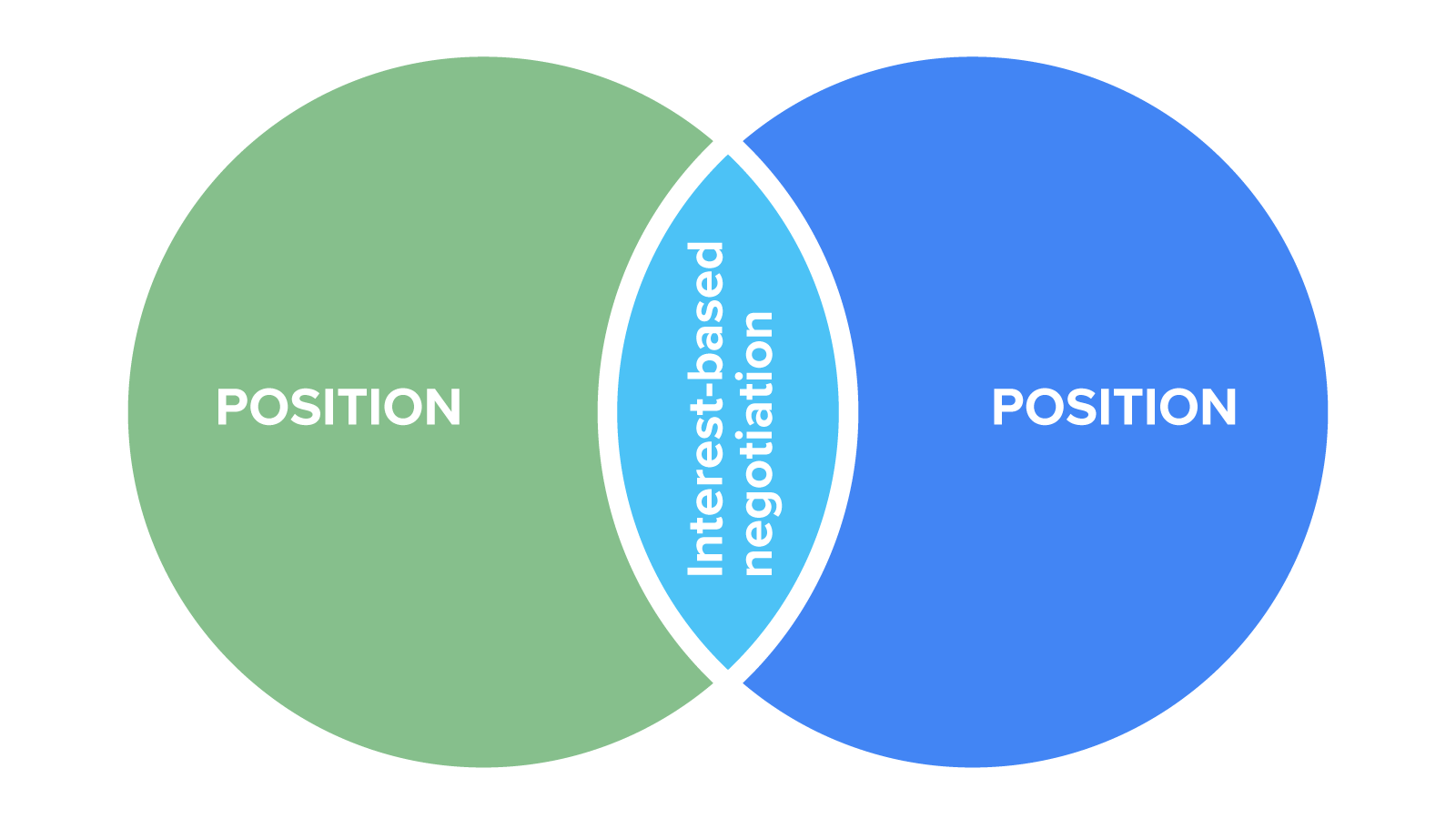Table of Contents |
Conflict resolution is a critical skill in personal, professional, and societal contexts. A fundamental aspect of resolving conflicts is understanding the distinction between positions and interests. These two concepts are often confused; however, recognizing the differences between them is essential for finding effective and sustainable solutions to any conflict. This lesson will explore the nuances between positions and interests, their roles in conflict resolution, and strategies for moving from positions to interests to reach mutually satisfactory outcomes.
When individuals or groups find themselves in conflict, they usually present positions that reflect what they believe they need. However, these positions are often surface-level expressions of deeper, underlying interests. Understanding the distinction between positions and interests is important for resolving conflicts effectively.
A position is the specific outcome or solution that a party demands in a conflict. It represents what a person wants and is typically the first thing they articulate when entering a dispute. Positions are often rigid and can lead to a stalemate if both sides refuse to compromise. However, positions are not always the best way to achieve underlying goals.
EXAMPLE
Ingrid wants her son to empty the dishwasher and take out the trash without needing multiple reminders. This demand is Ingrid’s position.
An interest, on the other hand, is the underlying reason for or motivation behind a position. Interests are the needs, desires, or concerns that drive an individual to take a particular stance. Unlike positions, interests are more flexible and can be met in various ways, instead of just through the initially stated position.
EXAMPLE
Ingrid’s true interest is to have her son contribute to the household chores and learn about responsibility, which will prepare him for independent living as an adult. This interest could be satisfied through various other chores or responsibilities, not necessarily the ones initially specified.Understanding the distinction between positions and interests allows for more productive conflict resolution. Often, conflicts arise because parties are fixated on their positions, believing that their specific demand is the only way to satisfy their interests. However, by exploring the underlying interests, alternative solutions can be found that satisfy both parties.
Positional bargaining is a common approach to conflict where each party takes a stance and negotiates back and forth, often making concessions to reach a middle ground. While this method can sometimes lead to a resolution, it often results in dissatisfaction because the underlying interests may not be fully addressed.
EXAMPLE
Imagine negotiating the price of a car. The seller wants a high price (position), and the buyer wants a low price (position). They may settle on a price somewhere in between, but both parties may feel that they did not get what they truly wanted. The seller might feel they sold too low, and the buyer might feel they paid too much.Interest-based negotiation, on the other hand, focuses on identifying and addressing the underlying interests of each party. By understanding why someone holds a particular position, negotiators can explore alternative solutions that satisfy the core needs of all involved.
EXAMPLE
If the car buyer and seller were to discuss their interests, they might discover that the seller needs money urgently (interest), while the buyer is more concerned with the car’s condition (interest).A solution could involve a slight price reduction if the seller agrees to include a warranty, thereby satisfying both parties’ interests.
In many conflicts, while positions may differ, underlying interests can be shared. Identifying these shared interests opens the door to creative problem-solving and can transform a conflict from a win-lose situation to a win-win scenario.
EXAMPLE
A boss insists that an employee work overtime (position), while the employee insists on leaving by 5:00 p.m. (position) to pick up their children. Upon exploring their interests, they find a shared interest in meeting the project deadline. They could then explore options such as the employee coming in earlier or working from home to fulfill both the need for family time and project completion.To effectively resolve conflicts, it’s important to move beyond positional bargaining and focus on the underlying interests. This shift allows for more flexibility in finding solutions that satisfy all parties.
To transition from positions to interests, following these steps:
EXAMPLE
If a colleague resists a proposed change without explanation, explore what might be driving their resistance. Perhaps they have concerns about how the change will affect their workflow, which they haven’t expressed.EXAMPLE
Consider a conflict between a tenant and a landlord over a rent increase. The landlord’s position is to raise the rent because of rising maintenance costs, while the tenant’s position is to avoid a rent increase because of financial constraints. By exploring interests, they might find shared interests, such as maintaining a good tenant–landlord relationship and ensuring the property is well kept. They could negotiate alternative solutions, such as the tenant performing some maintenance tasks in exchange for a lower rent increase.In some conflicts, interests are tied to deeply held values, such as beliefs about what is moral, ethical, or right. These value-based interests are nonnegotiable and cannot be traded or compromised in the same way that other interests can.
When a conflict involves value-based interests, the goal is not to change the other party’s values but to find a way to respect those values while still addressing the conflict. Value-based interests require a high level of sensitivity and respect during the resolution process.
EXAMPLE
A couple disagrees about using coupons for grocery shopping. One partner values buying organic, local food (value), while the other wants to save money by using coupons. Instead of trying to change the value of buying organic food, they could explore other ways to save money that don’t compromise their values, such as buying in bulk or shopping at farmers’ markets.
Resolving conflicts where interests are rooted in values can be challenging because these values are often integral to a person’s identity. The key is to focus on the nonvalue interests that can be negotiated, allowing for solutions that respect both parties’ values.
EXAMPLE
A family conflict arises over childcare. One side wants the children to attend religious services every Sunday, while the other side is less concerned about religion. Instead of trying to change each other’s values, they could negotiate a schedule that accommodates the religious family’s need while respecting the other family’s practices.Interest-based negotiation is a process that focuses on understanding the underlying interests behind each party’s position to find mutually beneficial solutions. Rather than simply bargaining over fixed positions, this approach encourages exploring the deeper needs, desires, and concerns driving those positions. By illustrating and understanding multiple positions, negotiators can uncover shared or complementary interests, opening the door to more creative and effective outcomes that satisfy all parties involved.
Interest-based negotiation is a strategy that focuses on satisfying the underlying interests of all parties, rather than simply trading positions. This approach can lead to more creative and mutually beneficial solutions.
Steps in an interest-based negotiation include:
EXAMPLE
In a workplace scenario, an employee needs to leave early to pick up their child (interest), while the employer needs to meet a project deadline (interest). They could explore options such as the employee working from home, adjusting their hours, or redistributing tasks among team members to meet both needs.During an interest-based negotiation, using I-statements and practicing active listening can mark the difference between effective and noneffective communication. As you know from previous lessons, these techniques help build trust and ensure all parties feel heard and understood.
EXAMPLE
In a community meeting about developing a public park, a participant might say, “I am concerned about preserving green space because it’s important for our community’s health and well-being.” This statement focuses on the speaker’s interest without blaming others.Sometimes, conflicts remain unresolved because certain interests are not expressed. It is important to create an environment where all parties feel comfortable sharing their true concerns.
EXAMPLE
In a negotiation over workplace duties, an employee might resist a new assignment because they feel unqualified, but they might not express this concern directly. By creating a supportive environment and asking open-ended questions, a manager could uncover this unexpressed interest and offer additional training or support.In many conflicts, each party may hold multiple positions, each related to different interests. Recognizing this complexity is key to finding a comprehensive solution.
When a party has multiple positions, they may engage in positional bargaining, trading elements of each position to achieve partial satisfaction in meeting their interests. However, this approach often leaves some interests unmet.
EXAMPLE
Workers on strike may have multiple demands, such as better pay, improved working conditions, and job security. Positional bargaining might result in partial satisfaction of these demands, but not all interests will be fully met.To fully resolve a conflict, it’s important to move from positional bargaining to interest-based negotiation. This involves identifying the underlying interests behind each position and finding creative ways to meet those interests.

EXAMPLE
In the case of Ingrid and her son, instead of rigidly insisting on specific chores, Ingrid could explore her son’s interests and find tasks that both lighten her load and align with his preferences. This might involve rotating chores or finding a long-term responsibility that he enjoys.As a conflict resolver, your role is to help the parties analyze their positions to uncover their underlying interests. By suggesting alternative positions and encouraging a focus on interests, you can guide the parties toward a more comprehensive and satisfactory resolution.
EXAMPLE
In a workplace conflict, a manager might help team members identify their interests, such as job satisfaction, work–life balance, and professional growth.By focusing on these interests, they can develop a work schedule or project plan that meets everyone’s needs.
Source: THIS TUTORIAL WAS AUTHORED BY MARLENE JOHNSON (2019) and STEPHANIE MENEFEE and TRACI CULL (2024). PLEASE SEE OUR TERMS OF USE.